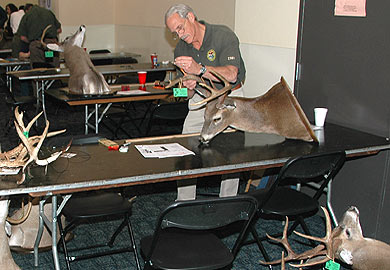DNR News** Archived Article - please check for current information. **
February 18, 2016Antler measuring sessions set across South Carolina
Antlers will abound throughout the Palmetto State as the search for new state record deer antlers gets underway during the S.C. Department of Natural Resources' annual series of measuring sessions.

Each year during March, the S.C. Department of Natural Resources (DNR) measures deer antlers throughout the state, with a major effort during the Palmetto Sportsmen's Classic scheduled for March 18-20 at the State Fairgrounds in Columbia. A total of 6,565 sets of white-tailed deer antlers, including 6,314 typical racks and 251 nontypical, are currently ranked on South Carolina's all-time antler records list, according to Charles Ruth, Deer and Wild Turkey Project coordinator for DNR. Minimum scores for state record listing are 125 points for typical antlers and 145 points for nontypical antlers. Measurements are based on the Boone and Crockett system.
The objectives of the state records list are to recognize outstanding animals and to identify areas that produce quality deer, according to Ruth. This information allows biologists to take a closer look at habitat and deer herd conditions in order to make future management recommendations.
Although record deer have been recorded from all counties, Aiken, Anderson, and Orangeburg counties have produced the greatest numbers in the past three to four years. Generally, larger deer are more abundant in areas that have fewer deer, as compared to parts of the state with high deer numbers, according to Ruth. Last year's measuring sessions produced 176 new entries into the South Carolina records list.
Hunters must provide necessary documentation, such as the date and county of the kill, and sign a "fair chase" statement when they bring in a set of antlers for measuring. Antlers in velvet or those that are broken and repaired or antlers separated from the skull plate cannot be officially measured for the state records list. If the lower jawbone of the animal was extracted during taxidermy or otherwise saved, it should be brought to the scoring session so biologists can determine the deer's age. An accurate weight measurement at the time of the kill is also helpful.
For additional information on the Antler Records Program visit the DNR website at the following address: https://www.dnr.sc.gov/wildlife/deer/index.html.
2016 Antler Measuring Sessions
- Thursday, March 3, 2 - 8 p.m., Pickens, Durham's Grocery, 3210 Walhalla Hwy., Six Mile, (864) 868-2070
- Friday, March 4, 8:30 a.m. - 5 p.m., Bath, Wilson's Taxidermy, 158 Victory Lane, (803) 593-3357
- Friday, March 4, 1 - 5 p.m., Gilbert, Price's Country Store, 540 Peach Festival Rd., (803) 892-2457
- Monday, March 7, 1 - 7 p.m., Greenwood, Hunter's Headquarters, 1845 Calhoun Rd., (864) 223-1911
- Tuesday, March 8, 2 - 8 p.m., Anderson, Academy Sports, 3423 Clemson Blvd., (864) 261-2400
- Thursday, March 10, 2 - 8 p.m., Greenville, Academy Sports, 59 Woodruff Industrial Ln., (864) 254-5900
- Wednesday, March 9, 9:30 a.m - 4 p.m., Bonneau, Dennis Wildlife Center, 305 Black Oak Road. Please call ahead (843) 825-3387
- Friday, March 18, noon to 8 p.m., Columbia, Palmetto Sportsmen's Classic, State Fairgrounds, (803) 734-3886
- Saturday, March 19, 9 a.m. - 6 p.m., Columbia, Palmetto Sportsmen's Classic, State Fairgrounds, (803) 734-3886
- Sunday, March 20, 1:30p.m. - 6 p.m., Columbia, Palmetto Sportsmen's Classic, State Fairgrounds, (803) 734-3886
- Clemson: At DNR Office, 311 Natural Resources Dr., by appointment only during March (864) 654-1671 ext. 16.
- Columbia: At DNR office, 1000 Assembly St., by appointment only any time of year, (803) 734-8738
- Florence: At DNR office, 295 S. Evander Dr., Florence, by appointment only during March, (843) 661-4768
- Garnett: Webb Wildlife Center, 1282 Webb Ave., by appointment only during March, (803) 625-3569
- Union: At DNR Office, 124 Wildlife Drive, Union, by appointment only during March, (864) 427-5140
